Venice, completed the restoration of the Polyptych of the Virgin by Vivarini and Giovanni d'Alemagna
The important restoration of the Polyptych of the Virgin, the work of Antonio Vivarini (Murano, 1420 - Venice, c. 1480) and Giovanni d’Alemagna (? - Padua, 1450), carried out with the collaboration of the carver Ludovico da Forlì for the precious wooden frame, made between 1440 and 1443 and placed in the Chapel of San Tarasio, in the church of San Zaccaria in Venice, has been completed. The restoration comes at the conclusion of a long and complex intervention by theCentral Institute for Restoration (ICR), which led to the restoration of the entire group of three precious polyptychs, made according to a unified project by the workshop of Antonio Vivarini for the Chapel of San Tarasio.
The restoration of the Polyptych of the Virgin, which has already been relocated to the Chapel of St. Tarasio, brings to completion a long project, begun in 2013, that over a period of nine years led the Central Institute for Restoration to fully restore the three polyptychs made by the workshop of Antonio Vivarini to decorate the altars of the Chapel of St. Tarasio: first the Polyptych of Saint Sabina (altar on the left), then the Polyptych of the Body of Christ (altar on the right), and finally the Polyptych of the Virgin (central altar). All activities were carried out in constant coordination with the Soprintendenza Archeologia Belle Arti e Paesaggio for the Municipality of Venice and Laguna and the Patriarchal Curia of Venice, with the active participation of the Dutch Committee for Venice.The restoration was directed by Giuliano Romalli in collaboration with Francesca Romana Liserre (for architectural aspects), and was performed by Federica Di Cosimo, Francesca Fumelli, Patrizia Giacomazzi, Serena Sechi, and Gloria Tranquilli with the collaboration of Paola Minoja for the pictorial reintegration, while the scientific investigations were carried out by Giulia Galotta, Maria Rita Giuliani, Elisabetta Giani, Mauro Torre, Fabio Aramini, Paolo Scarpitti, Fabio Talarico, and Gianfranco Priori, and by Davide Bussolari’s Diagnostica Fabbri and Stefano Ridolfi’s Ars Mensurae companies, with the external collaboration of the Gallerie dell’Accademia in Venice. Paolo Scarpitti handled the restoration of the wooden supports in collaboration with Roberto Saccuman, while the photographic documentation is by Angelo Raffaele Rubino, Edoardo Loliva and Claudio Santangelo.
The three restorations were conducted in a similar manner: the panels painted by Antonio Vivarini and Giovanni d’Alemagna were initially removed to be restored in Rome in the laboratory, and before being returned, the carved, gilded and painted wooden frames by the carver Ludovico da Forlì were instead maintained on site by contracting an outside firm under ICR supervision. On the occasion of the last intervention, the one on the Polyptych of the Virgin, the maintenance of the wooden frame was carried out directly by the ICR with the formula of the educational worksite and the participation of the students of the School of Higher Education, as part of the PFP2 training course. To crown this first important project just concluded, concerning the polyptychs of the Vivarini workshop, a new conservation intervention is being prepared, which will affect the frescoes by Andrea del Castagno on the vault and the pictorial decorations on the walls of the Chapel.
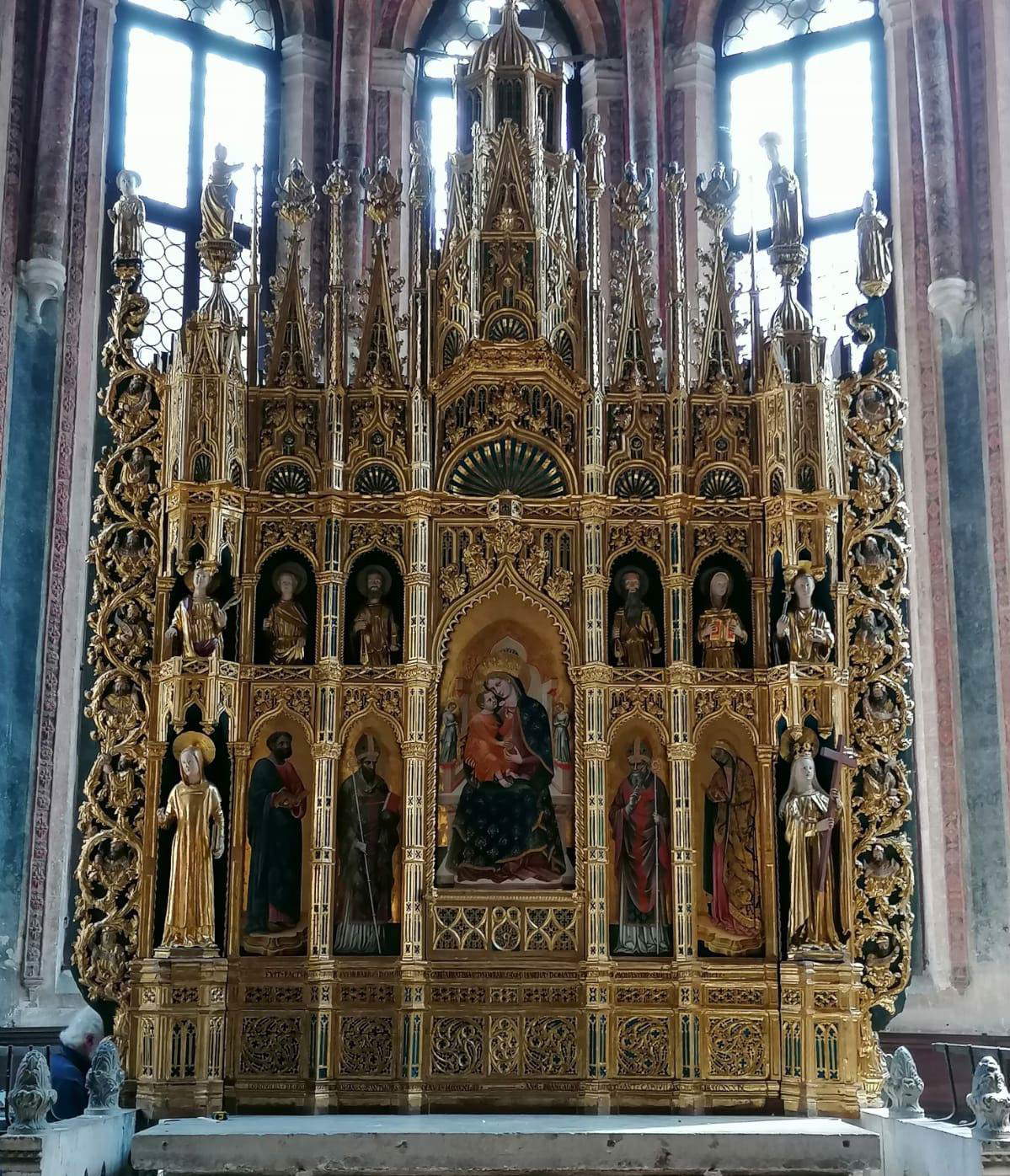 The Polyptych of the
The Polyptych of the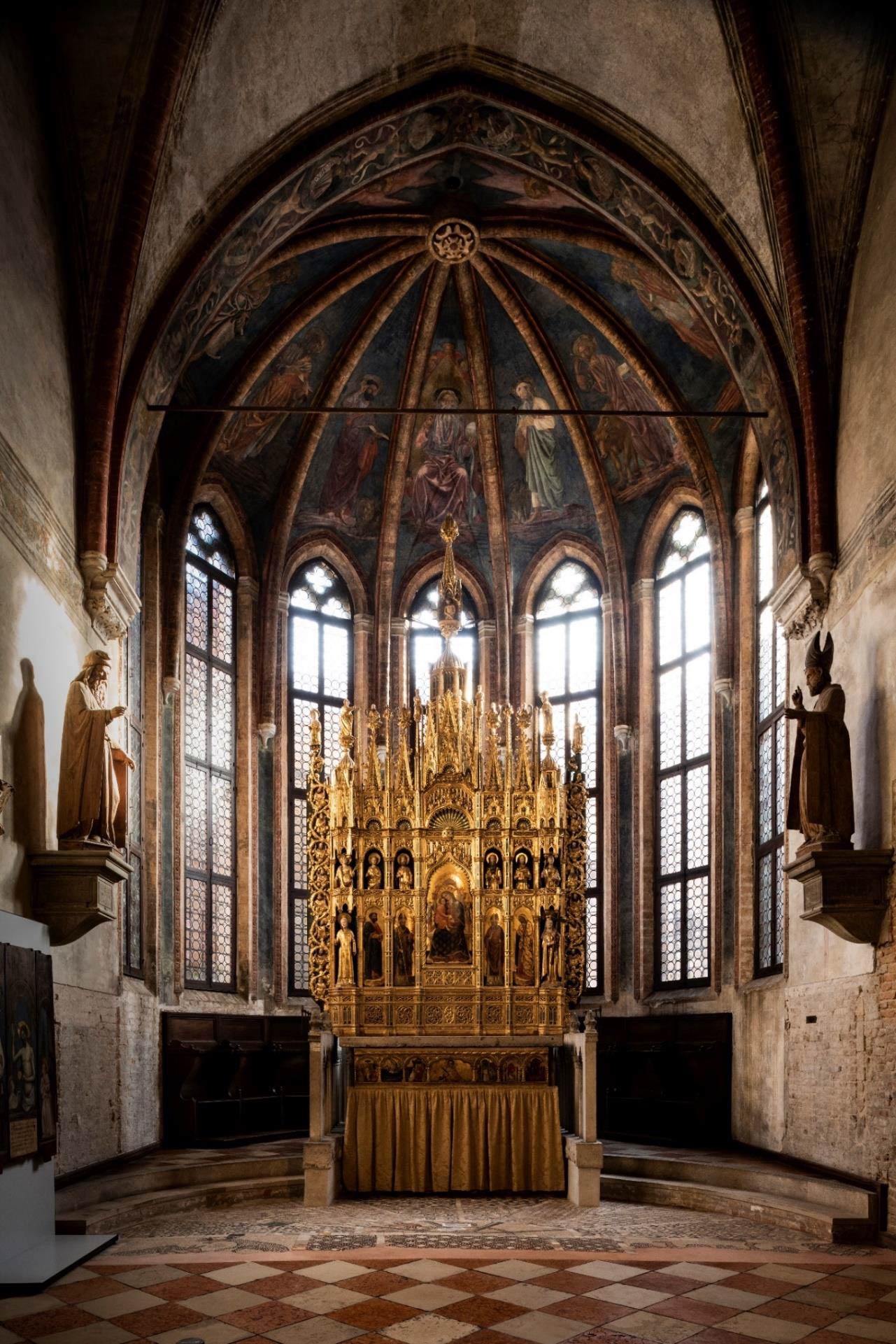
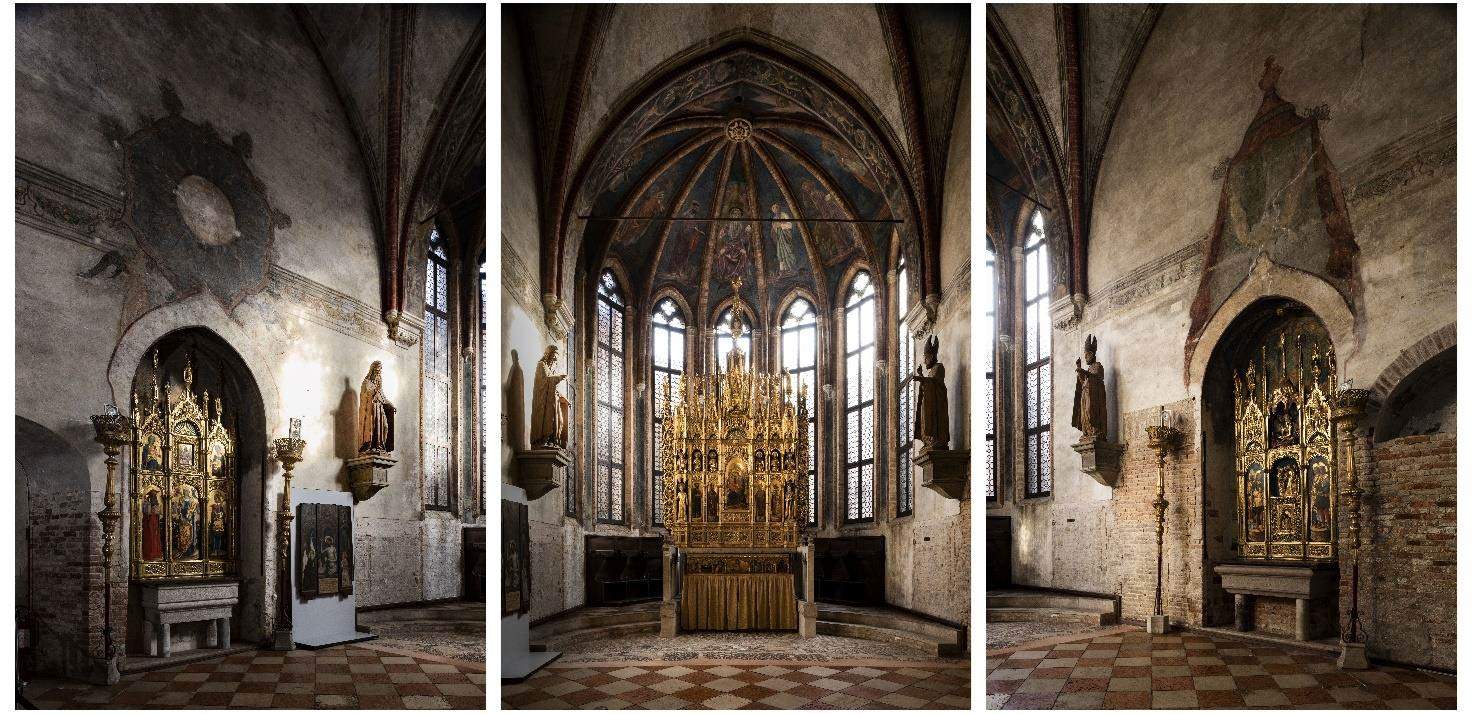
The Polyptych of the Virgin
The five panels recently restored at the ICR laboratories in Rome, depicting the Virgin Enthroned with Child, St. Mark, St. Elizabeth, St. Blaise and St. Martin, come from the Polyptych of the Virgin, one of the three large altar machines made in 1443 by the workshop of Antonio Vivarini to decorate the three altars of the Chapel of St. Tarasius in the Church of St. Zaccaria. It is a grandiose structure that within a complex gilded wooden frame, painted and enriched with busts of saints carved in wood, integrates on the recto the five panels being restored at the ICR workshop, and on the verso a large reliquary-cabinet, where the saints whose relics were kept are painted on the doors.
In fact, only two of the five panels restored at the ICR laboratories belong to the original arrangement of the Vivarini polyptych and can be directly traced to the hand of the Murano painter and his associate Giovanni d’Alemagna: they are those depicting St. Mark and St. Elizabeth, placed at either end of the polyptych. The other three panels, namely the central ones depicting the Virgin Enthroned with Child, St. Blaise and St. Martin, come from another dismembered polyptych and are the work of the painter Stefano “pievano di Sant’Agnese,” as the artist himself signs in the central panel depicting the Virgin, while dating the work to 1385. Stefano is a Venetian artist related fundamentally to the manner of Paolo and Lorenzo Veneziano, but also informed by the manner of other representative painters of the Venetian scene of the second fourteenth century such as the Paduan Guariento. About ten panel works, mostly polyptychs or erratic panels, dated between 1369 and 1385, are now attributed to Stefano.
The presence of the three panels painted by Stefano di Sant’Agnese within the Polyptych of the Virgin is due to a 19th-century restoration, through which 3 original panels from the Vivarini workshop, evidently damaged or lost, were replaced with as many works by Stefano recovered from the dismembered polyptych of the Scuola dell’Arte dei Forneri (Fornai) in Santa Maria dell’Orto. To the lost polyptych of Stephen also likely belongs the painted predella with St. Apollinaris and St. Thomas Beckett, which is now allocated on the front of the central altar of the Chapel of St. Tarasius, just below the Polyptych of the Virgin.
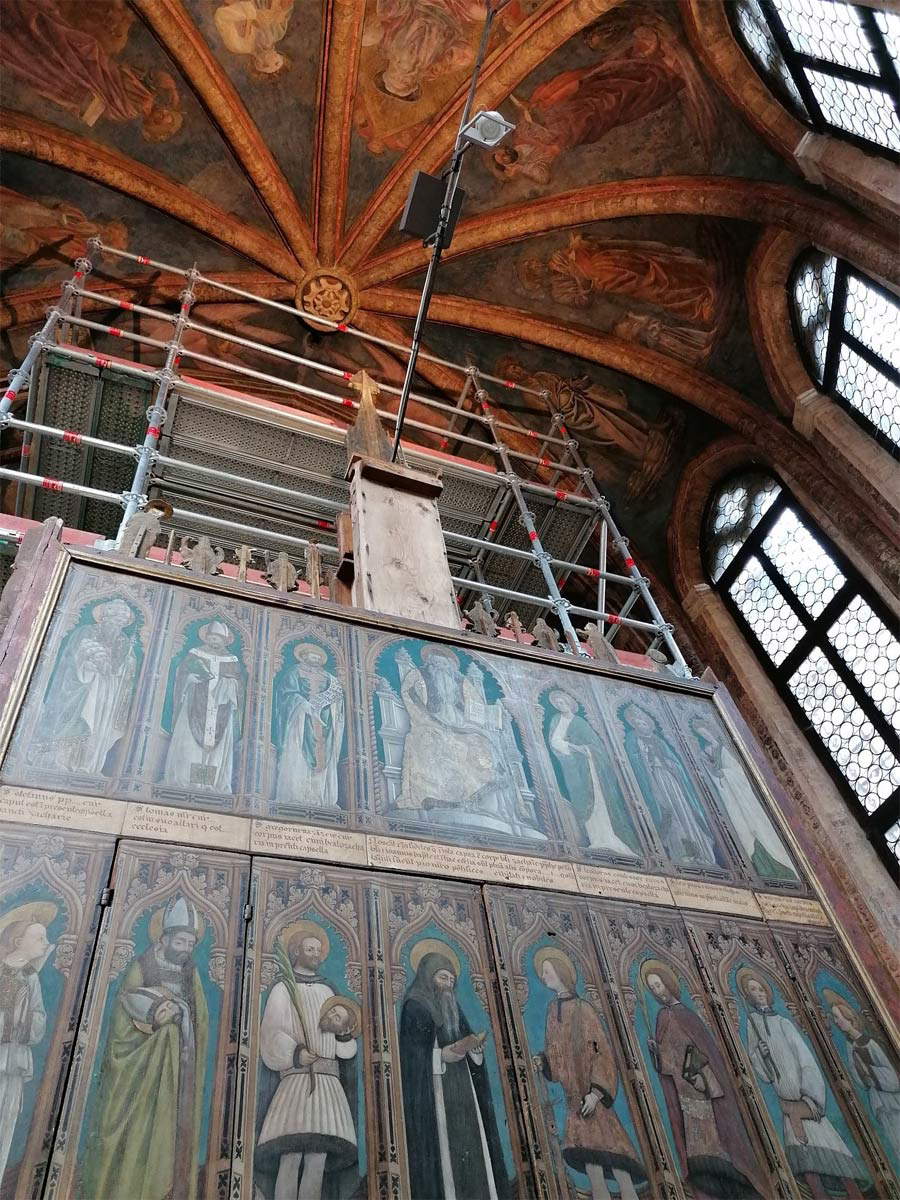 Polyptych of the
Polyptych of the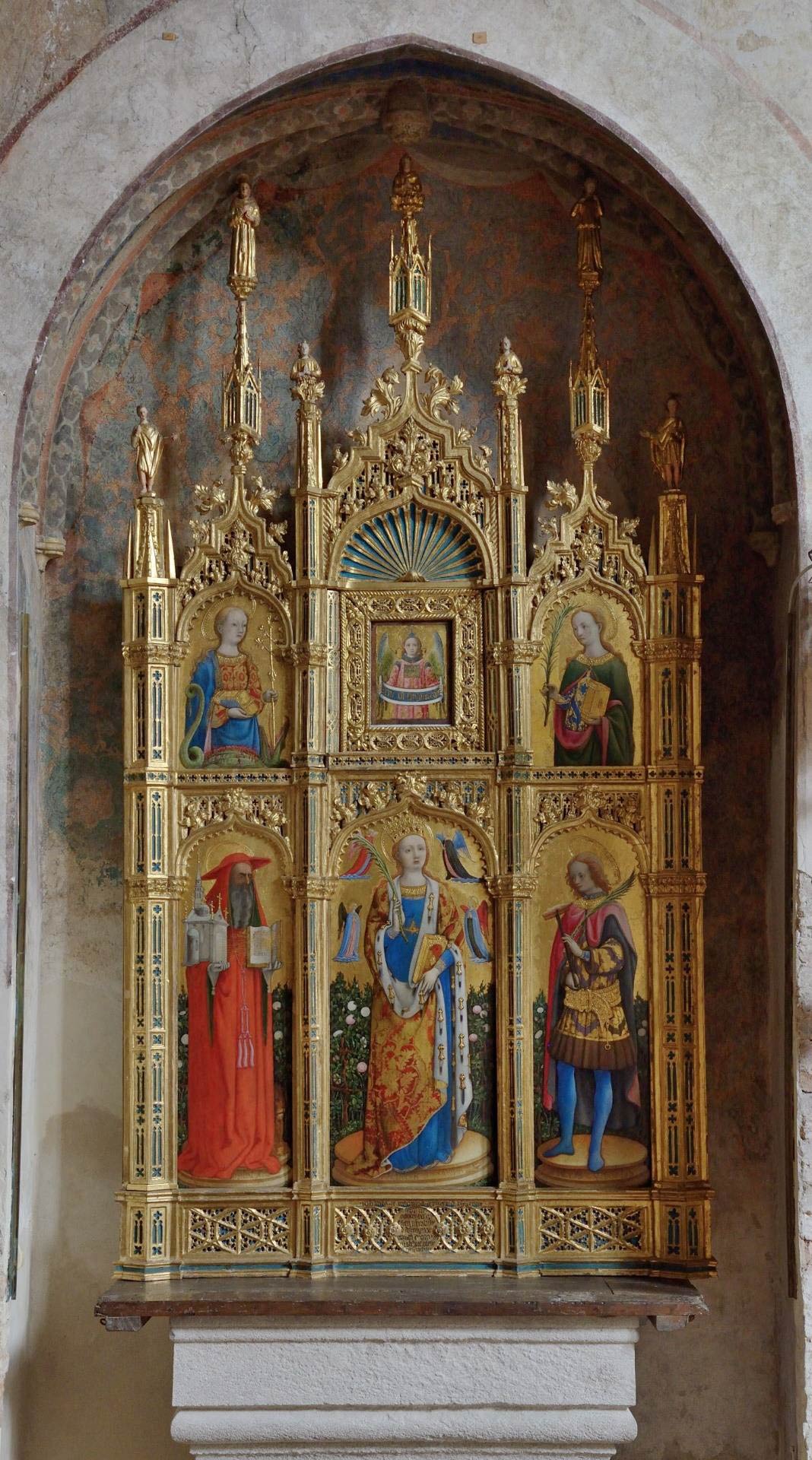 The Polyptych of
The Polyptych ofThe Polyptych of the Body of Christ and the Polyptych of Saint Sabina.
Conceived according to a unified project as an accompaniment to the major polyptych or of the Virgin, and characterized like the latter by the close association between the figurative component on panel and the complex wooden machinery of the frame, the two polyptychs made by the workshop of Antonio Vivarini for the side altars of the Chapel of St. Tarasius also combined ornamental purpose with a precise functionality.
The polyptych of the Body of Christ, placed above the altar inserted in the niche to the right of the presbytery space, was intended to hold the consecrated host, which was placed in the central flap decorated with a depiction of theImago Pietatis, that is, of the half-figure Christ with the body wounded by the signs of the Passion. In the polyptych of St. Sabina, positioned on the altar inserted in the niche of the opposite wall, on the other hand, was kept the precious relic of the blood of Christ, which was placed in the flap identified by the figure of a half-length Angel caught in the act of unwinding the scroll bearing the inscription “Hic est sanguinis Christi.”
While in the latter polyptych the figurative component on panel tends to prevail, unfolding on the three large panels of the lower register with the refined images of St. Jerome, St. Sabina and St. Lizerio full-length, and on the half-length Saints Margaret and Agatha of the upper level, in the Polyptych of the Body of Christ the painted panels are reduced to only the side compartments of the’lower order, where the full-length figures of saints appear paired together; the central portion of the large altar machine, however, is dominated by the plastic prominence of the bas-relief with the Pious Women above the door for the Eucharist, and especially by the extraordinary full-length group with the risen Christ from the tomb, which occupies the central compartment of the upper register. Unlike the Polyptych of the Virgin, where the three central panels were replaced in the nineteenth century by as many paintings by the Venetian painter Stefano di Sant’Agnese, in both the Polyptych of the Body of Christ and the Polyptych of St. Sabina the figurative panels are all original and traceable to the hand of Antonio Vivarini and Giovanni d’Alemagna.
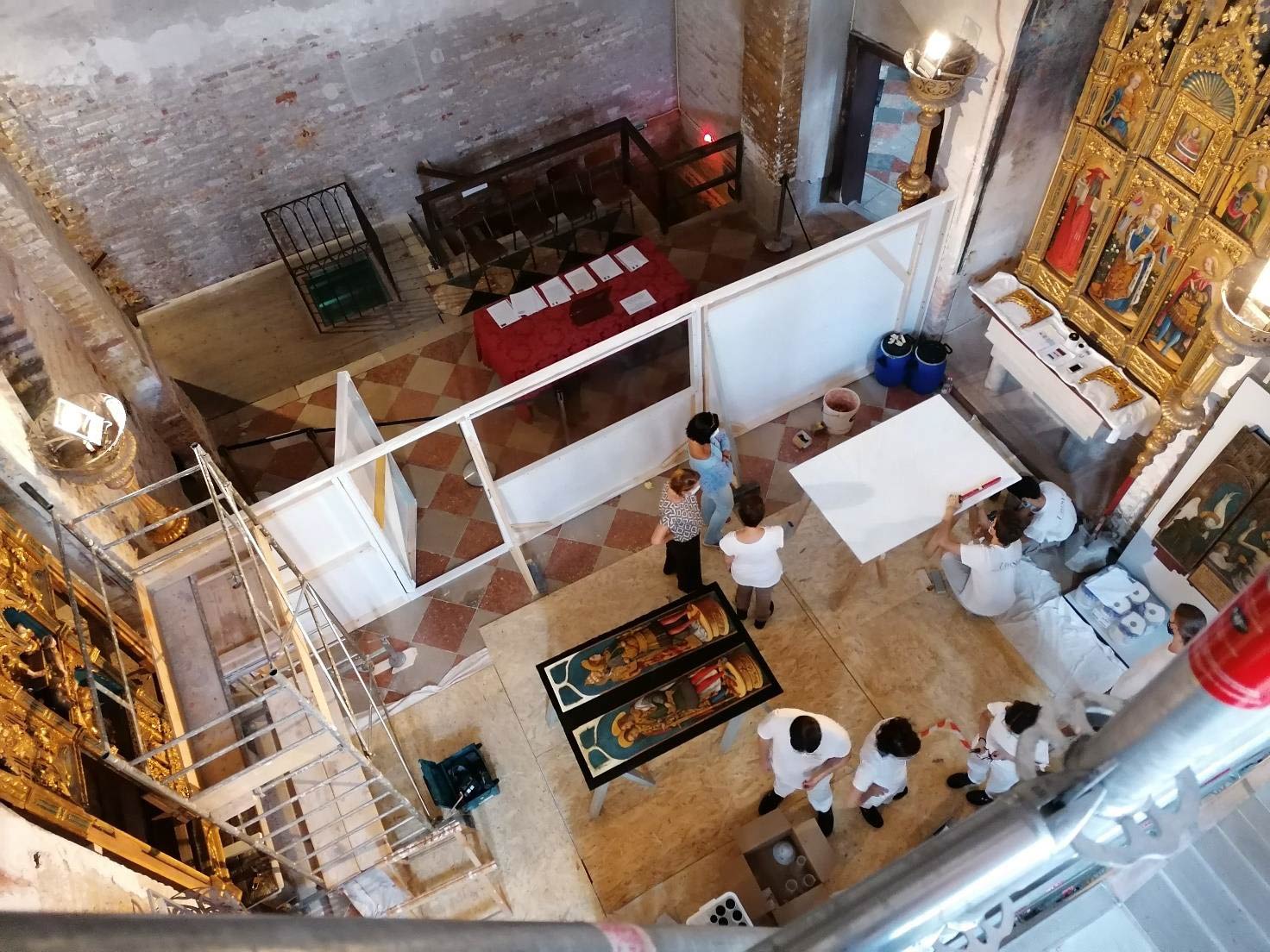
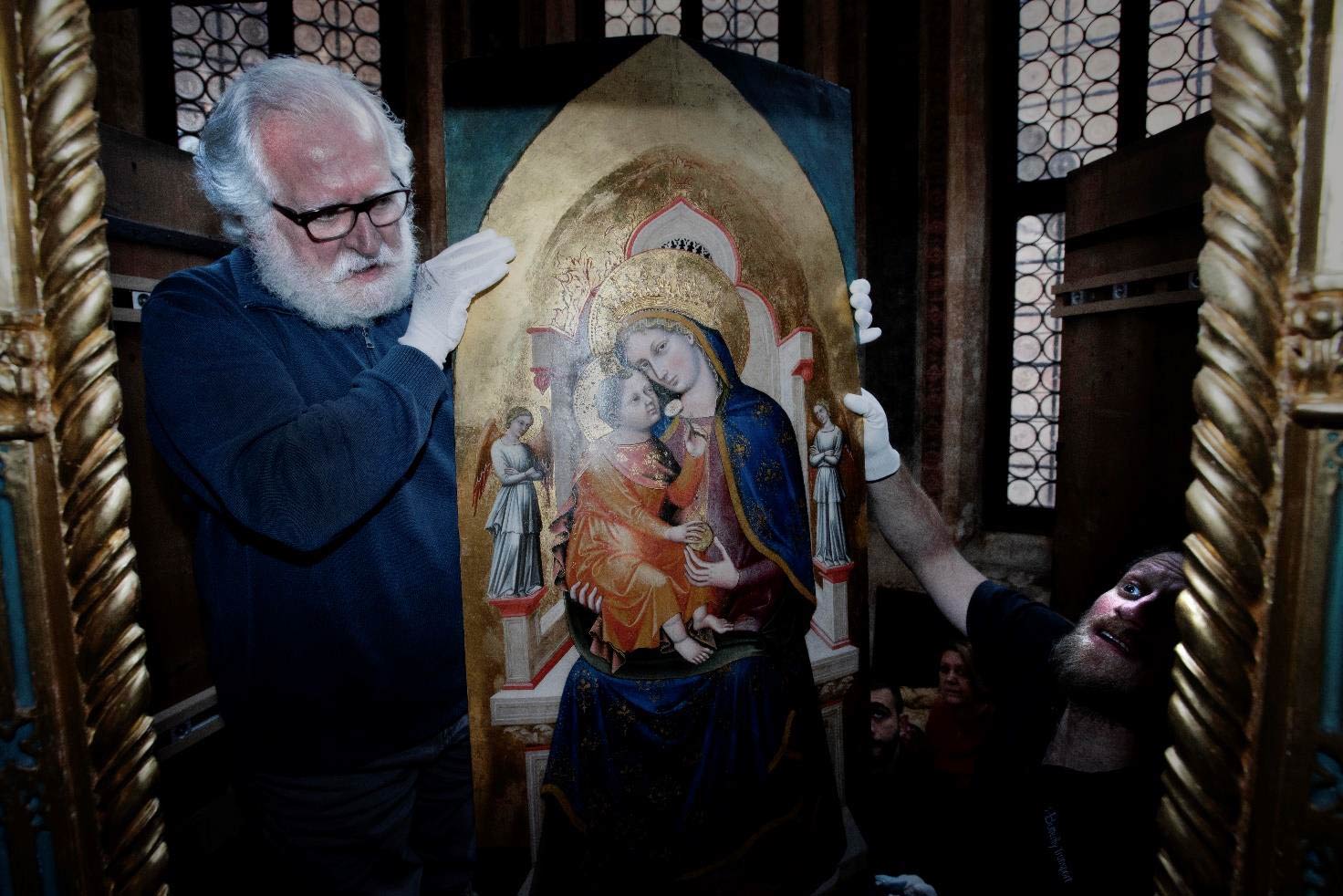
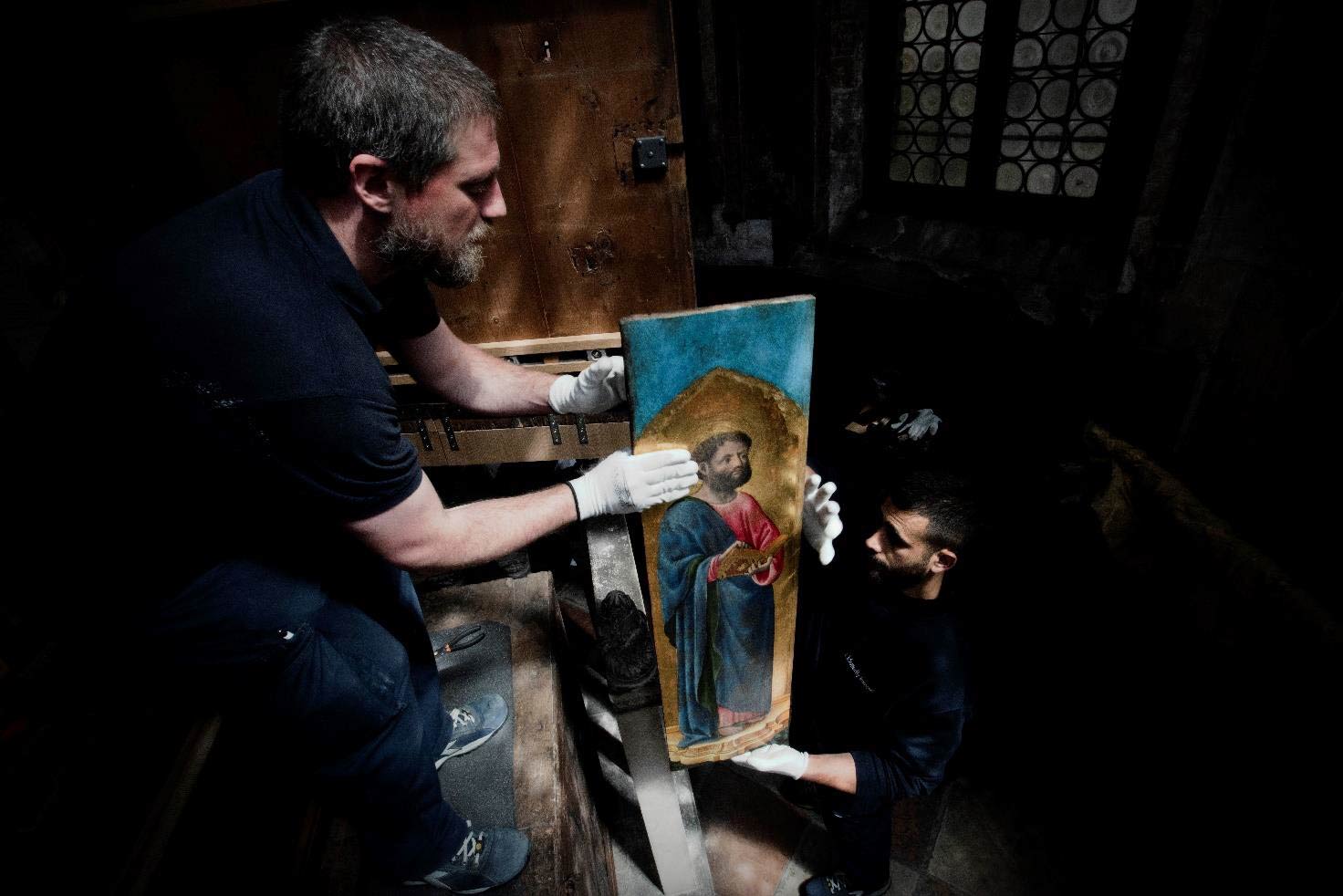 Rearrangement
RearrangementThe Chapel of St. Tarasius
Also known as the “Golden Chapel” because of the refinement of its architectural structure and the richness of its ornamental apparatus, it was built and decorated between 1440 and 1443 on the initiative of the powerful abbess Elena Foscari, sister of Francesco, the longest-serving doge in the history of the Venetian Republic. The chapel at that time replaced the central apse of the first church of San Zaccaria, a building probably dating back to the 9th century that had been entirely rebuilt in the Romanesque period after the disastrous fire of 1105. But as early as 1460 the Romanesque church was completely rebuilt to a design by Mauro Codussi. However, the intervention spared the Chapel of St. Tarasius, which from that time went to form a kind of room adjacent to the new apse and accessible for devotional purposes.
To decorate the polygonal structure of the Gothic chapel erected between 1440 and 1443 were called, in those years, some of the most representative artists of the Italian scene: the young Andrea del Castagno, who had recently been active on the Florentine scene, was entrusted with the execution of the frescoes that embellish the vault sails and the apsidal arch, while the Murano painter Antonio Vivarini and his transalpine-born associate Giovanni d’Alemagna, in collaboration with the carver Ludovico da Forli, created the extraordinary complex of the three large polyptychs that went to surmount the high altar and the two side altars of the chapel: the Polyptych of Saint Sabina on the left altar, the Polyptych of the Body of Christ on the right altar, and the Polyptych of the Virgin on the central altar.
The impressive decorative complex prepared between 1440 and 1443 in the Chapel of St. Tarasius celebrated the importance of the Church of St. Zaccaria, which, due to its proximity to St. Mark’s Basilica and possession of Venice’s most important holdings of relics, was considered a sort of second dogal chapel, the destination of processions and visits involving the doges themselves. Most of the relics possessed by the Church of San Zaccaria were collected precisely in the Chapel of San Tarasio, where they found their place inside the reliquary-cabinet set up at the back of the Polyptych of the Virgin and in the two side altars.
The artistic and cultural context
Antonio Vivarini is the progenitor of a famous workshop of painters active in Murano, in which his brother Bartolomeo and his son Alvise were trained and worked: a workshop that in terms of importance and production in the Venetian 15th-century panorama is comparable to that of the Bellinis.
Antonio represents one of the greatest exponents of Venetian late Gothic painting in its final phase, the one following Gentile da Fabriano’s passage to the lagoon (c. 1410). In his works, mainly panels or complexes of panels set in polyptychs, the Byzantine influences still dominant in 14th-century Venetian painting completely give way to the refined late Gothic language imported into the lagoon by Gentile, with wide openings toward already Renaissance modes, thanks also to Antonio’s contact with Andrea Mantegna, with whom he worked on the fresco decoration of the Ovetari Chapel in the Church of the Hermits in Padua.
For a long period Antonio Vivarini associated the German Giovanni d’Alemagna with his workshop, signing numerous polyptychs with him, in a relationship of mutual influences that has not yet been fully clarified by critics. From Antonio Vivarini’s workshop came above all precious polyptychs, destined for the main Venetian churches, but also destined for wide fortune throughout the Adriatic area: several Vivarini polyptychs are still preserved today in Apulia. The activity of Antonio Vivarini, Giovanni d’Alemagna, and the Murano workshop effectively marked the boundary line in Venice between late Gothic and Renaissance painting, which would soon come to dominate with the activity of Carpaccio, Giovanni Bellini, and their contemporaries.
 |
| Venice, completed the restoration of the Polyptych of the Virgin by Vivarini and Giovanni d'Alemagna |
Warning: the translation into English of the original Italian article was created using automatic tools. We undertake to review all articles, but we do not guarantee the total absence of inaccuracies in the translation due to the program. You can find the original by clicking on the ITA button. If you find any mistake,please contact us.




























